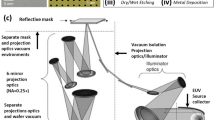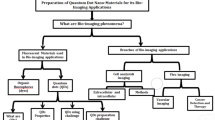Abstract
In order to study cell electroporation in situ, polymer devices have been fabricated from poly-dimethyl siloxane with transparent indium tin oxide parallel plate electrodes in horizontal geometry. This geometry with cells located on a single focal plane at the interface of the bottom electrode allows a longer observation time in both transmitted bright-field and reflected fluorescence microscopy modes. Using propidium iodide (PI) as a marker dye, the number of electroporated cells in a typical culture volume of 10–100 μl was quantified in situ as a function of applied voltage from 10 to 90 V in a series of \({\sim}\)2-ms pulses across 0.5-mm electrode spacing. The electric field at the interface and device current was calculated using a model that takes into account bulk screening of the transient pulse. The voltage dependence of the number of electroporated cells could be explained using a stochastic model for the electroporation kinetics, and the free energy for pore formation was found to be \(45.6\pm 0.5\) kT at room temperature. With this device, the optimum electroporation conditions can be quickly determined by monitoring the uptake of PI marker dye in situ under the application of millisecond voltage pulses. The electroporation efficiency was also quantified using an ex situ fluorescence-assisted cell sorter, and the morphology of cultured cells was evaluated after the pulsing experiment. Importantly, the efficacy of the developed device was tested independently using two cell lines (C2C12 mouse myoblast cells and yeast cells) as well as in three different electroporation buffers (phosphate buffer saline, electroporation buffer and 10 % glycerol).










Similar content being viewed by others
References
Bard A, Faulkner L (2001) Electrochemical methods: fundamentals and applications. Wiley, New York
Beunis F, Strubbe F, Marescaux M, Beeckman J, Neyts K, Verschueren ARM (2008) Dynamics of charge transport in planar devices. Phys Rev E 78(011):502–515
Chalmers JJ, Haam S, Zhao Y, McCloskey K, Moore L, Zborowski M, Williams PS (1999) Quantification of cellular properties from external fields and resulting induced velocity: Cellular hydrodynamic diameter. Biotechnol Bioeng 64:509–518
Chang DC, Chassy BM, Saunders JA, Sowers AE (1992) Guide to electroporation and electrofusion. Academic Press, San Diego
Conway BE, Bockris JOM, Ammar IA (1951) The dielectric constant of the solution in the diffuse and helmholtz double layers at a charged interface in aqueous solution. Trans Faraday Soc 47:756–766
Dubey AK, Dutta-Gupta S, Kumar R, Tewari A, Basu B (2009) Time constant determination for electrical equivalent of biological cells. J Appl Phys 105(084):705–708
Dubey AK, Banerjee M, Basu B (2011) Biological cell electrical field interaction: stochastic approach. J Biol Phys 37:39–50
Dubey AK, Kumar R, Banerjee M, Basu B (2012) Analytical computation of electric field for onset of electroporation. J Comput Theor Nanosci 9:1–7
Escoffre JM, Dean DS, Hubert M, Rols MP, Favard C (2007) Membrane perturbation by an external electric field: a mechanism to permit molecular uptake. Eur Biophys J 36:973–983
Escoffre JM, Hubert M, Teissie J, Rols MP, Favard C (2014) Evidence for electro-induced membrane defects assessed by lateral mobility measurement of a GPi anchored protein. Eur Biophys J 43:277–286
Fox MB, Esveld DC, Valero A, Luttge R, Mastwijk HC, Bartels PV, van den Berg A, Boom RM (2006) Electroporation of cells in microfluidic devices: a review. Anal Bioanal Chem 385:474–485
French DM, Uhler MD, Gilgenbach RM, Lau YY (2009) Conductive versus capacitive coupling for cell electroporation with nanosecond pulses. J Appl Phys 106(074):701–704
Gabriel B, Teissie J (1998) Fluorescence imaging in the millisecond time range of membrane electropermeabilisation of single cells using a rapid ultra-low-light intensifying detection system. Eur Biophys J 27:291–298
Garner AL, Neculaes VB (2012) Extending membrane pore lifetime with ac fields: a modeling study. J Appl Phys 112(014):701–707
Garner AL, Deminsky M, Neculaes VB, Chashihin V, Knizhnik A, Potapkin B (2013) Cell membrane thermal gradients induced by electromagnetic fields. J Appl Phys 113(214):701–711
Glaser RW, Leikin SL, Chernomordik LV, Pastushenko VF, Sokirko AI (1988) Reversible electrical breakdown of lipid bilayers: formation and evolution of pores. Biochim Biophys Acta 940:275–287
Grosse C, Schwan HP (1992) Cellular membrane potentials induced by alternating fields. Biophys J 53:1632–1642
Haberl S, Miklavcic D, Sersa G, Rubinsky B (2013) Cell membrane electroporation-Part 2: the applications. IEEE Electr Insul M 29:29–37
Hai A, Spira M (2012) On-chip electroporation, membrane repair dynamics and transient in-cell recordings by arrays of gold mushroom-shaped microelectrodes. Lab Chip 12:2865–2873
Isambert H (1998) Understanding the electroporation of cells and artificial bilayer membranes. Phys Rev Lett 80:3404–3407
Jain T, Papas A, Jadhav A, McBride R, Saez E (2012) In situ electroporation of surface-bound sirnas in microwell arrays. Lab Chip 12:939–947
Joshi RP, Hu Q (2012) Role of electropores on membrane blebbing: a model energy-based analysis. J Appl Phys 112(064):703–707
Kim J, Cho K, Shim M, Lee W, Jung N, Chung C, Chang J (2008) A novel electroporation method using a capillary and wire-type electrode. Biosens Bioelectron 23:1353–1360
Kinosita K, Ashikawa I, Saita N, Yoshimura H, Itoh H, Nagayama K, Ikegami A (1988) Electroporation of cell membrane visualized under a pulsed-laser fluorescence microscope. Biophys J 53:1015–1019
Leguebe M, Silve A, Mir LM, Poignard C (2014) Conducting and permeable states of cell membrane submitted to high voltage pulses: mathematical and numerical studies validated by the experiments. J Theor Biol 360:83–94
Lu H, Schmidt MA, Jensen KF (2005) A microfluidic electroporation device for cell lysis. Lab Chip 5:23–29
Miklavcic D, Towhidi L (2010) Numerical study of the electroporation pulse shape effect on molecular uptake of biological cells. Radiol Oncol 44:34–41
Nawarathna D, Unal K, Wickramasinghe HK (2008) Localized electroporation and molecular delivery into single living cells by atomic force microscopy. Appl Phys Lett 93(153):111–113
Neu JC, Krassowska W (1999) Asymptotic model of electroporation. Phys Rev E 59:3471–3482
Neumann E, Schaefer-Ridder M, Wang Y, Hofschneider PH (1982) Gene transfer into mouse lyoma cells by electroporation in high electric fields. EMBO J 1:841–845
Olbrich M, Rebollar E, Heitz J, Frischauf I, Romanin C (2008) Electroporation chip for adherent cells on photochemically modified polymer surfaces. Appl Phys Lett 92(013):901–903
Olesen LH, Bazant MZ, Bruus H (2010) Strongly nonlinear dynamics of electrolytes in large ac voltages. Phys Rev E 82(011):501–529
Pakhomova ON, Gregory BW, Khorokhorina VA, Bowman AM, Xiao S, Pakhomov AG (2011) Electroporation-induced electrosensitization. PLoS One 6:e17100
Pliquett U, Gift EA, Weaver JC (1996) Determination of the electric field and anomalous heating caused by exponential pulses with aluminum electrodes in electroporation experiments. Bioelectrochem Bioenerg 39:39–53
Potter H (1988) Electroporation in biology: methods, applications, and instrumentation. Anal Biochem 174:361–373
Puc M, Corovic S, Flisar K, Petkovsek M, Nastran J, Miklavcic D (2004) Techniques of signal generation required for electropermeabilization. Survey of electropermeabilization devices. Bioelectrochemistry 64:113–124
Pucihar G, Kotnik T, Teissie J, Miklavcic D (2007) Electropermeabilization of dense cell suspensions. Eur Biophys J 36:173–185
Pucihar G, Krmelj J, Rebersek M, Napotnik TB, Miklavcic D (2011) Equivalent pulse parameters for electroporation. IEEE Trans Biomed Eng 58:3279–3288
Rebersek M, Miklavcic D (2011) Advantages and disadvantages of different concepts of electroporation pulse generation. Automatika (Zagreb) 52:12–19
Saulis G, Lape R, Praneviciute R, Mickevicius D (2005) Changes of the solution pH due to exposure by high-voltage electric pulses. Bioelectrochemistry 67:101–108
Shahini M, Yeow JTW (2013) Cell electroporation by cnt-featured microfluidic chip. Lab Chip 13:2585–2590
Tarek M (2005) Membrane electroporation: A molecular dynamics simulation. Biophys J 88:4045–4053
Ting CL, Appelo D, Wang ZG (2011) Minimum energy path to membrane pore formation and rupture. Phys Rev Lett 106(168):101–104
Troiano GC, Stebe KJ, Raphael RM, Tung L (1999) The effects of gramicidin on electroporation of lipid bilayers. Biophys J 76:3150–3157
Tsong TY (1991) Electroporation of cell membranes. Biophys J 60:297–306
Valero A, Post J, Nieuwkasteele J, Braak P, Kruijer W, Berg A (2008) Gene transfer and protein dynamics in stem cells using single cell electroporation in a microfluidic device. Lab Chip 8:62–67
Wang S, Lee LJ (2013) Micro-/nanofluidics based cell electroporation. Biomicrofluidics 7(011):301–314
Weaver JC, Chizmadzhev YA (1996) Theory of electroporation: a review. Bioelectrochem Bioenerg 41:135–160
Weaver JC, Mintzer R (1981) Decreased bilayer stability due to transmembrane potentials. Phys Lett 86A:57–59
Yarmush ML, Golberg A, Sersa G, Kotnik T, Miklavcic D (2014) Electroporation-based technologies for medicine: principles, applications, and challenges. Ann Rev Biomed Eng 16:295–320
Yoo JS, Won N, Kim HB, Bang J, Kim S, Ahn S, Soh KS (2010) In vivo imaging of cancer cells with electroporation of quantum dots and multispectral imaging. J Appl Phys 107(124):702–709
Yu M, Lin H (2014) Quantification of propidium iodide delivery with millisecond electric pulses: a model study. arXiv:1401.6954
Acknowledgments
We thank Bigtec Labs for the yeast samples. We also thank the Division of Biological Sciences for the FACS facility, Department of Biotechnology and Department of Science and Technology.
Author information
Authors and Affiliations
Corresponding author
Rights and permissions
About this article
Cite this article
Majhi, A.K., Thrivikraman, G., Basu, B. et al. Optically transparent polymer devices for in situ assessment of cell electroporation. Eur Biophys J 44, 57–67 (2015). https://doi.org/10.1007/s00249-014-1001-x
Received:
Revised:
Accepted:
Published:
Issue Date:
DOI: https://doi.org/10.1007/s00249-014-1001-x




